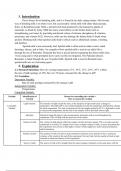Essay
Biology IA (21/24)
- Course
- Institution
Quality Biology IA received a score of 21/24. The IA can be used as guidance and as inspiration when writing your own IA. Make sure to not copy as that can lead to plagiarism and only use this as a guidance to write your own.
[Show more]



